

Posted on 10/08/2005 8:08:00 AM PDT by Republicanprofessor
In our last “class” on Greco-Roman, Early Christian and Byzantine Art, we saw how the realism of Greece and Rome was repudiated for more spiritual abstraction. The Christians saw the soul as more important than the weighty, physical body, and thus their works were flat and filled with the gold of paradise. My connection to spiritual twentieth century abstraction received mixed results, but that’s fine.
Today, we’ll see how artists gradually added some bulk and realism to their work from 1000-1400. Then in the next “class,” we’ll study how the Italian Renaissance united a rebirth of Greco-Roman realism with Christian subject matter.
The Dark Ages, from 600-800 A.D., saw little in the way of new forms of art. There were some beautiful portable objects fashioned by the roaming tribes of Vandals and Goths, but we’ll skip ahead. There were also some fine things made under Charlemagne around 800 A.D and under the Ottonians in Germany in the tenth century. We begin to get some monumental architecture at this time. Charlemagne’s Palace Chapel at Aachen revived much of the Byzantine glory from San Vitale in Ravenna, Italy; but Charlemagne’s architect, Odo of Merz, made the palace chapel at Aachen more solid and overtly powerful. They are both octagonal structures, but there is a much more complex spirituality, use of space and mosaics in the earlier San Vitale.


Charlemagne’s Palace Chapel at Aachen c. 800 and Justinian’s San Vitale 526-47
Hildesheim Cathedral is a wonderful work of Ottonian architecture. The stripes from here and from Aachen may derive from Islamic architecture (such as the Cordova mosque in Spain). You may also notice that t Hildesheim the walls are mostly bare; there are no columns to connect the arches below to the windows above. This will change as time goes on, and the walls will get busier and busier. What I also love about Hildesheim are the first monumental bronze doors since antiquity. This image of Adam and Eve being admonished by God is a classic case of passing the buck. The little figures are not very realistic, but the narrative is very clear, and that’s what they were striving for. I love it.

The mosque at Cordova.



Hildesheim Cathedral of St. Michael, bronze doors thereof
Now we jump into the Romanesque age proper. Medieval people believed that the world would end in 1000. When it didn’t, they began building massive churches in thanksgiving. These monumental buildings were not only used for church services, but they were also places of fortified protection in case of barbarian attacks. They were fireproof, acoustically wonderful and roomy enough for the added pilgrims. (One of the most “popular” events of the Middle Ages was making a pilgrimage to one of many sites, including Santiago de Compostela in Spain.)



Church of Ste. Foy, in Conques, France: exterior, west façade, nave view
Now we have to look at the architecture carefully and use difficult vocabulary words. This is even more difficult because I can’t be in the front of the class motioning to the buildings themselves. This architecture is called Romanesque because of its use of rounded Roman arches. This is continued into three dimensions in the barrel vault across the nave, the wider central aisle. Often there are two stories: the main story (called the nave arcade because of those arches alongside the nave,) and the second story called the gallery. At this time, the gallery allowed additional space for the pilgrims (and others) to gather upstairs for the service. They could also walk around the ambulatory, or aisle around the choir (or central, most sacred section of the church). Thus if mass was going on, others could walk around the mass and light their candles in the chapels off the apse (the rounded east end of the church) or the transept (that part that makes a cross of the church). These churches often had relics from one or more saints in the forms of reliquaries. I particularly like this reliquary of Ste. Foy (Saint Faith) at this same church.


Now, a constant concern of the Romanesque time was how to create lighting in these buildings. One cannot put a window into a barrel vault, just as one cannot remove a stone from an arch without it collapsing. One solution was to develop the groin vault, an intersection of two barrel vaults. The lovely church of Ste. Madeleine at Vezelay, France has such groin vaults and thus an upper clerestory of light (in addition to the lovely Medieval striping we’ve seen before). It is hard sometimes to see the edges of the groin vaults; they look a great deal like a barrel vault, but they aren’t. (If you look even more closely, you’ll see the Vezelay choir is Gothic in style. These churches were built over many decades, and as their styles often changed accordingly.)

It is also fun to study the decoration on these churches. There is not a great deal of Romanesque sculpture that is not connected to a church, and most of the painting of this time is tied to illuminated manuscripts. The rounded entrance to most of the churches (the tympanum) is often decorated with sculpture of the Last Judgment. Can you tell which side is Heaven and which is Hell? The elongated, skinny and non-realistic figures tell the story very well, especially the imaginative depictions of Satan and hell.

One wonderful work of Romanesque embroidery is the Bayeux Tapestry, commemorating the French Norman Conquest of England in 1066. It is over 200’ long and has wonderful, imaginative and lively figures gesturing, fighting and even cooking.

This is also the time of castles, and of troubadours singing of their lost ladies. One can even visit many of these castles as a tourist in Europe, either for the day or overnight. They are not much more expensive than a normal hotel room and have much more atmosphere (and sometimes an accompanying medieval dinner).

So how did Gothic architecture develop? Well, there was an orphan boy outside of Paris who was adopted by the church. In time, he became an abbot: Abbot Suger, who once presided over France when King Louis VII went off on the second crusade. Abbott Suger saw rich, beautiful visual objects as a way to approximate the glory of heaven. When his church of St. Denis was being rebuilt, the new choir contained pointed arches, rib vaults, and stained glass windows. The space here is less compartmentalized than that of the Romanesque churches. The consecration of this new spacious choir in 1144 is what begins the Gothic age.

Each Gothic cathedral is wonderful and unique; but it is too much to detail their full development here. Suffice it to say that Chartres rivaled Notre Dame in Paris. Pointed arches replaced round arches, allowing more height and the development of pointed vaults with ribs. They grew ever higher and higher, until reaching 144’ to the top of the rib vaults at Amiens Cathedral. They developed six-part and four-part rib vaults. Instead of the wide gallery on the second level, they developed a shallow level called the triforium, first seen at Chartres. Flying buttresses channeled the weight and energy from the ceiling out to the pier buttresses, so that the walls could open up to stained glass windows. The upper clerestory at Chartres is as high as the nave arcade, probably over 45’, since the cathedral reaches to 120’ to the top of the vaults. At the smaller chapel of La Sainte Chapelle, the walls are 75% glass. (The only buildings to surpass this structure of glass are the skyscrapers of the twentieth century.)

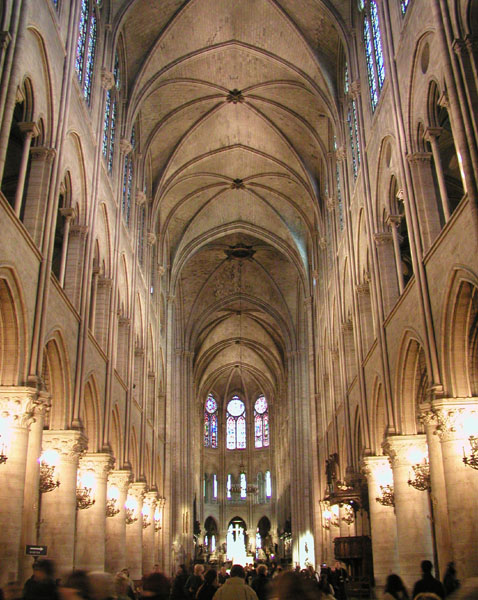
Notre Dame Paris with its matching towers and 6-part rib vaults


Chartres with its different towers, a higher clerestory and 4-part vaults;

Amiens with its 144’ vaults

La Ste-Chapelle with its 75% glass.
The Gothic was a time of new veneration for the Virgin Mary. The forgiveness of Christ took the place of the damning images from the Romanesque churches. Gothic sculpture became rounded and more realistic. In fact, as you walk right around Chartres Cathedral, you can see the development of sculpture from the 1194 west façade (or entrance) to the south portal (1205) and the north portal (1210). It’s really fun when you can recognize certain scenes: note Abraham and Isaac. I also love all the odd little sculpture under their feet, over their heads, etc. They had wonderful imaginations in the Middle Ages.



The great Gothic painter, from 1305, is actually called a proto-Renaissance artist because of the sense of weight and realism he ushered in. Giotto painted a series of frescos on the walls of the Arena Chapel in Padua that are wonderful in terms of color, composition and human content. His figures are well shaded (or modeled) and are no longer the flat, elongated figures of the Bayeaux Tapestry. For the first time since Roman times, he is actually looking at live models and drawing from them. His composition is simple and focused upon the simple gestures of Christ. For the first time, he uses the backs of figures and imbues them with emotion and character. His work is incredible and has inspired those as diverse as Masaccio, Michelangelo and Matisse (whose bright color and simplified compositions may be said to reflect some of Giotto’s work, however abstract they are in our eyes).
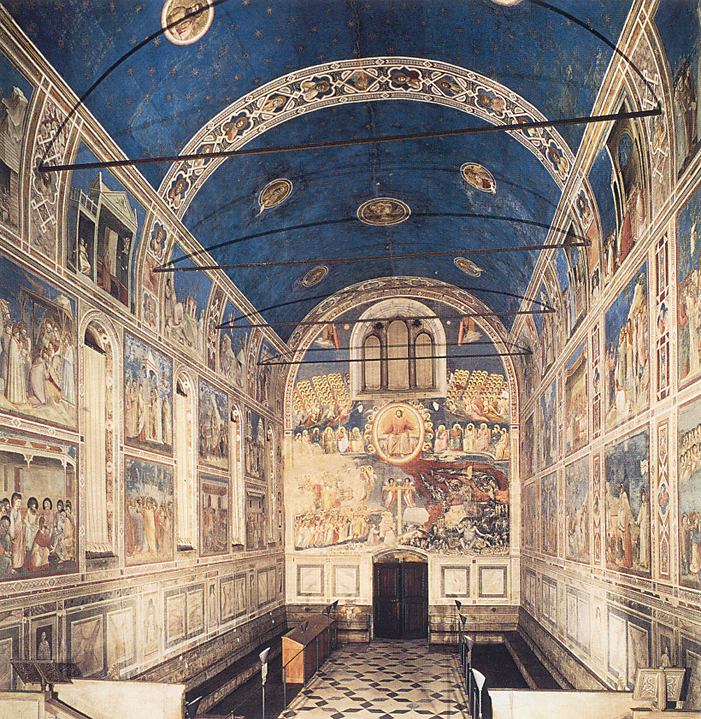
The Arena Chapel looking west toward the door.
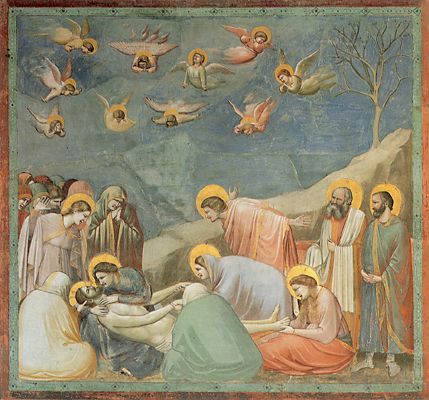
The famous Lamentation.

The meeting of Mary’s parents at the Golden Gate when they know that they will bear her. Such a tender embrace is rare in art history.
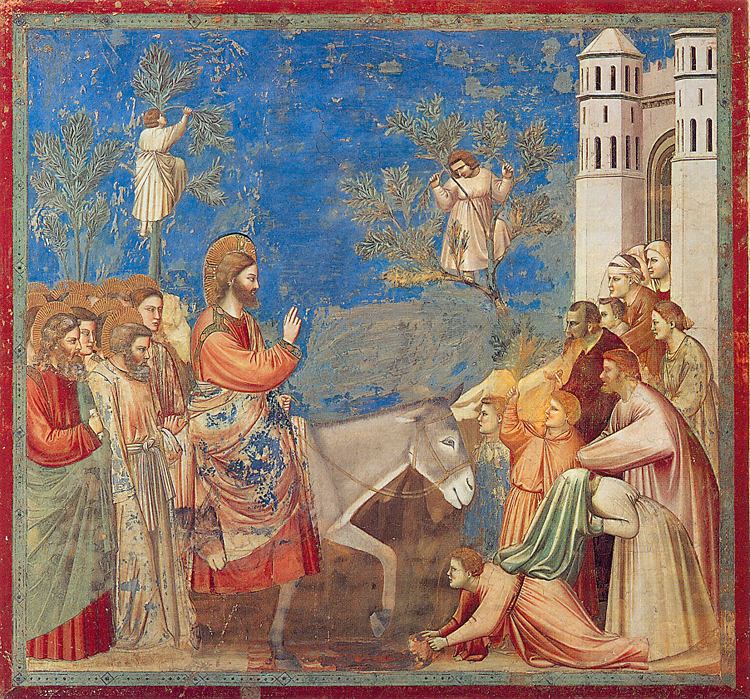
My favorite is the Entry into Jerusalem, with the little figure on the right stuck in his cloak. He wanted to lay it down for Jesus, but he’s going to miss the whole event because he’s stuck. It is those human touches that move me the most.
I'm curious, and even worried, about Liz. I hope she's just off on a long vacation. She hasn't posted in months, whether art or other political comments. Maybe she's just gotten really busy. If anyone knows anything, please let us know too.
Aachen was delightful. We stayed at a hotel right next to the old medieval gate to the city. It is very nice for walking around. They had a public art display that consisted of fiberglass horses decorated in various ways like the cows on parade in Chicago and Kansas City. You never knew when you would come upon one. We took the train from there down the Rhine to Heidelberg which I just adored.
Had Dürer never seen a lion? He had clearly seen a Corgi or similar type European herding dog . . . but maybe there weren't any lions handy, or just a badly stuffed example?
You're right about the time period. I guess I kind of lumped everything from the 1400's to 1500's as part of the Gothic era.
My personal fav engraving that he did is "The Knight, Death and The Devil". His self portraits and paintings of nobility and peasants were all hightly detailed.
I need to put her pics up because they're fabulous.
At Notre Dame, it is interesting to visit the towers, where you can see that they are partially constructed of massive wooden beams (to save weight over stone).
I am under the impression that the difference between English Gothic and French Gothic is the color of the glass. The French used much more blues and reds than the English. In many French cathedrals, the glass was taken down during WWI and again during WWII to protect it from being destroyed by war.
St. Denis remains on my list of places to visit in the future when I get a chance.
I don't know that I would call Chartres Romanesque. The facade dates from before 1194, the date in which there was a fire that destroyed all but the facade and one bay of the cathedral. Since the Gothic style was born in 1144, I think the facade is still Gothic, but definitely Early Gothic. The arches are only barely pointed, and the facade is not nearly as busy as later cathedrals (like Amiens or Reims). The arches are also "recessed" into the wall, rathe than projecting out. But because of the rose window (even heavy as it is with stone) and the pointed arches, it is definitely early Gothic. But I don't know about any previous church on the site. It does dominate the sky line, but so did any of the cathedrals of the time. They showed how important God was to the town (vs. what our commercial skyscrapers say about what is important to us nowadays.)

Reims Cathedral, a busy High Gothic facade with stained glass at the tympanums instead of sculpture. Very lovely.
I haven't ever been up in Notre Dame's towers. Interesting point about the use of wood. They were originally to have pointed caps on them but, as was often true, they ran out of money.
It is true that they took the stained glass out of the churches for both world wars. Chartres is the only cathedral with all (or most) of its original stained glass.
There are actually three different styles of English Gothic: Early, Decorated and Perpendicular. English Gothic is more horizontal and, in its later styles, has some of the wildest vaulting I have ever seen.
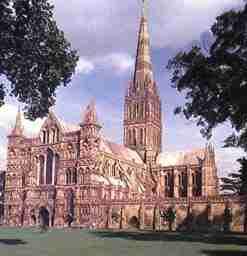
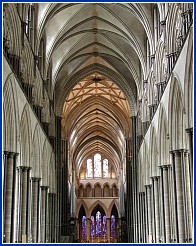
Salisbury Cathedral, Early English Gothic. Note the more horizontal emphasis, inside and out.

Lincoln Cathedral, still Early English but with "crazy vaults"


Ely Cathedral, Decorated English style, with an awesome octagonal tower.

Chapel of Henry VII, Westminster Abbey, 16th century. The Gothic style lasted longer in England than anywhere else. This is now the perpendicular style; note the "stalactite" vaulting.
You posted some beautiful photographs, RP.
Yes, IMO, the analogy between Christian abstract and 20th century abstract is apt, ironic as it may seem.
I find a wonderful combination of delicacy, ethereality and solidity in Gothic architecture, I truly love it. Been to Winchester, Salisbury, Rheims, Notre Dame and Chartres, though it's been years. They left an impression on me. Knowing a little of the history of those places and the events and culture of the time makes them all the more fascinating.
OTOH, I'm just (re)learning Romanesque, after inadvertantly posting an example, so thank you so much for the thread!
I started the summer series with the 19th century Realism of Manet in the 1860s because that's where the development of abstraction begins: with the flattening of the picture plane. (After all, after the invention of the camera in 1839, painters were freed to move away from realism.) I wanted to show the reasoning behind abstraction for those who dismiss it too quickly.
I was originally a little nervous about the series. Now I can't imagine that that was true. It's been so much fun.
I think that when one teaches art, you really need to add art history to the studio classes. One of my colleagues also adds studio projects to the art history classes (like drawing perspective) but I have so much to say about the art history that I just don't make time for it. But I do show cubist, expressionist and surrealist slides for my painting classes and a variety of other things for my drawing classes. As you noted, it makes their own art so much richer.
Well, you were the inspiration for this post; I'm so glad you've enjoyed it.
It's been a few years since I was in Paris. Too many people miss La Ste-Chapelle, with all that lovely stained glass, and it's just a 10 minute walk from Notre Dame.
I am always amused by my trip to Notre Dame with a group from school when I was 14. I wanted to become Catholic! The mystery of confession and the huge cathedral, were overpowering. Of course, that's just the reaction they wanted in the Middle Ages. (I never did convert; I realize now that I fell in love with the art and architecture, and to that I've remained addicted.)
The earliest record of a cathedral on the site dates to 743. Fires struck then, in 858, in 962, and 1020.
Apparently the facade was built around 1155. I can't find my book on Chartres but I vaguely recall there being some Romanesque elements (cylindrical columns, round arches in the center) mixed with Gothic elements (Rose window, pointed arches under the towers).
However, even the rose window could be viewed as displaying the Romanesque cylindrical column theme between the interior "petals."
(Did you walk the labyrinth?)
I also liked the Sainte Chapelle church next to the Notre Dame in Paris for its stained glass windows. Much prettier than Salisbury or Westminster (to my taste)-- more fundamental colors, less pastels and yellows.
I would speculate that the use of wood in Gothic cathedral towers might be common and not just specific to Notre Dame in Paris, to save weight, but it would be nice to hear or read confirmation of that.
Please place me on the ping list.
I've added you to two ping lists: my main Art Ap/Education ping list for these series of "lectures" and also to the general, fun art ping list.
I love your name. I've enjoyed "your" novels quite a bit.
Thank you! What fantastic threads.
Indeed. MacCauley's books are my staples for teaching. Or at least the videos, especially when I am ill. Cathedral is one of my favorites. Pyramids is also good.
|
· join list or digest · view topics · view or post blog · bookmark · post a topic · subscribe · |
|||
Antiquity Journal & archive Archaeologica Archaeology Archaeology Channel BAR Bronze Age Forum Discover Dogpile Eurekalert LiveScience Mirabilis.ca Nat Geographic PhysOrg Science Daily Science News Texas AM Yahoo Excerpt, or Link only? |
|
||
|
· Science topic · science keyword · Books/Literature topic · pages keyword · |
|||
Please add me too.
Disclaimer: Opinions posted on Free Republic are those of the individual posters and do not necessarily represent the opinion of Free Republic or its management. All materials posted herein are protected by copyright law and the exemption for fair use of copyrighted works.